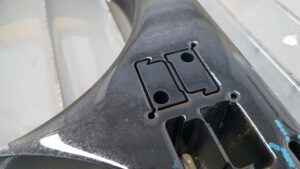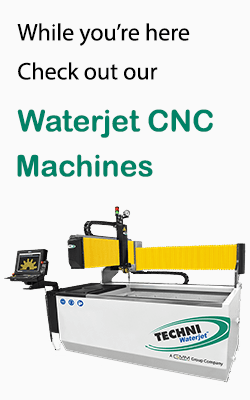Acrylic materials find a lot of applications in areas that require sturdy materials with excellent aesthetics for projects such as signage. The high strength that makes acrylic materials useful is also the reason they need a high-quality cutting process. Which cutting process is the most popular? Waterjet cutting acrylic has become the go-to choice in this regard.
Even so, many professionals often inquire about the benefits of waterjet cutting acrylic against other alternative processes. This article will explore the technology behind waterjet cutting acrylic in detail, its benefits, and some tips to improve cuts.
Can You Cut Acrylic With a Water Jet Cutter?
Yes. Waterjet cutting can easily create clean and smooth cuts in acrylic material. Abrasive waterjet cutting uses a high-pressure stream of water mixed with garnet or other abrasive particles before being released through a precision cutting nozzle. Waterjet cutters can even cut through multiple acrylic sheets stacked on top of each other up to 12 inches thick.
What are the Benefits of Cutting Acrylic With Waterjet Cutting?
Here are some of the advantages that apply to waterjet cutting acrylic and many other plastic materials:
No Heat-Affected Zones
When waterjet cutting acrylic, there is no formation of heat-affected zones. Water jet cutting is a cold-cutting process and doesn’t generate heat in the subject material. Therefore, there is no temperature rise, resulting in a clean cut without burn marks on the acrylic material.
Efficient & Cost Effective
Abrasive waterjet cutting acrylic is very cost-effective. It can even handle cutting through multiple acrylic sheets stacked on top of each other, speeding up productivity significantly. This stacking technique isn’t possible with other alternatives like laser cutting. It makes waterjet cutting the most efficient cutting method available.
Precise & intricate designs
A waterjet machine has options such as 3-axis, 4-axis, and 5-axis cutting heads. Higher-axis machines can cut the most intricate and complex designs in 3D. In fact, it is possible to produce entire acrylic parts or for signage or medical purposes with a waterjet cutter without any second machining requirements.
Highly accurate cutting with minimal tolerances
The high level of precision is because waterjet cutting does not produce any thermal damage, unlike laser or plasma methods. As a result, tolerances can be as low as 0.001 inches or less.
High Safety
A water jet does not create any heat while cutting. It generates no toxic fumes – something normal when plastics come in contact with heat – as in many traditional cutting methods. Additionally, there is no requirement for the operator to handle the cutting head manually, as it’s driven by CNC. This makes waterjet cutting a very safe method.
Versatile
An abrasive waterjet stream can cut through many different materials besides acrylics. These materials include thick rubber, plastics, glass, metals, wood, and paper. Therefore, when a waterjet cutter is not doing acrylic cutting, it can also be used for many other purposes. For soft materials like rubber and paper – cuts made by a pure water jet are adequate. A pure waterjet doesn’t need any abrasive added to the water stream.
Minimal material wastage
The waterjet cutting process is a cold-cutting process, so there is no heat-affected zone or HAZ on the edges of the material. This means that any scrap can be recycled and reused again in other applications. As a result, it significantly reduces overall material wastage compared to other traditional cutting methods.
A cold-cutting process with no hazardous fumes and waste
Most traditional cutting methods generate hazardous fumes and waste, which can be dangerous in some environments. Waterjet cutting is a cold-cutting process that produces no hazardous fumes or waste. As such, it is ideal for use in cleanroom environments and food processing areas, where safety is paramount.
Environment-friendly
As mentioned earlier, the water jet doesn’t release toxic fumes during acrylic cutting. Additionally, the water gets recycled into the system. Therefore, waterjet cutting acrylic is one of the most environmentally friendly methods.
Applications of Waterjet Acrylic Cutting
There are many use cases for waterjet cutting of acrylic materials. Different types of acrylic sheets are used in industries like marketing, hospitality, interior decoration, architecture, art and craft, automotive, and more.
Here are some of these use cases:
- Shelves and contours
- Skylights
- Signage, display, logos
- LED panels
- Architectural glazing
- Displays
- Automotive taillights
- Medical devices
Tips for Cutting Acrylic With a Water Jet Cutter
It is clear from the advantages mentioned above that a waterjet is the best method for acrylic cutting. Here are some tips that you can use to get the best results from this method:
Underwater Cutting
Cutting acrylic sheets can make a loud noise in the workplace. However, the development of submerged waterjet cutting as an option helps keep noise to a minimum. How does it achieve this? The cutting table holding the acrylic sheets is submerged in water. Therefore, the water-jet machine doesn’t create any noise during cutting.
Stacking
For a project that requires consistent shapes cut from acrylic sheets, the stacking method is the best way to achieve maximum efficiency. Place multiple acrylic sheets on top of each other with a total thickness of about 12 inches, and cut them simultaneously with one waterjet machine.
Optimizing Design
The speed of waterjet cutting can be increased by optimizing certain design elements. For instance, sharp corners can take longer to cut, so replace them with curved corners and edges to save time. Doing this speeds up cutting and creates smooth and aesthetically pleasing corners.
How to Choose the Right Waterjet Acrylic Cutter?
When deciding which waterjet acrylic cutting machine to buy, make your choice by focusing on the factors below:
- Machine Axes: There is the option to choose the number of axes you want in your waterjet cutter. A machine with more cutting axes can cut complex shapes but also costs more.
- Build Quality: Some people make the mistake of going for an inferior product just to save a few bucks. However, since waterjet cutters are heavy industrial equipment, their breakdown can lead to extended downtime resulting in significant losses. Therefore, it’s best to invest in a high-quality machine with good spare part availability.
- Budget: Waterjet cutters have a wide price range. Set a budget so you can narrow down the selection of machines and features that are feasible. Certain desirable features, like underwater cutting, will increase what you need to spend.
Best Waterjet Cutter For Acrylic Cutting
Techni Waterjet machines are the best solution for acrylic cutting based on the factors mentioned. Our waterjet machines are made with the highest quality build, suitable for cutting acrylics, plastics, rubber, glass, metals, and many different materials. Additionally, being a reputable company, spare parts are available at short notice whenever required.
Conclusion
Due to the many advantages of a waterjet, it’s undoubtedly the best way to cut acrylics and many other materials. Professionals already realize this fact and use waterjet cutting as the go-to method to produce different shapes from acrylic sheets.
To get the most out of a waterjet machine to cut acrylic, apply the tips and information provided above. Additionally, using a high-quality machine such as those supplied by Techni Waterjet will bring more advantages. Contact us at Techni Waterjet to find the best machine for your requirements.





